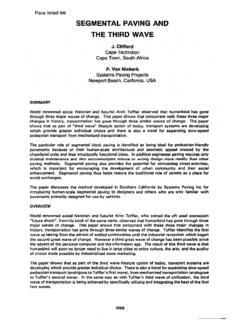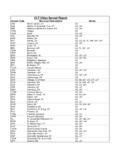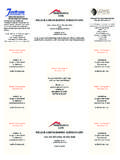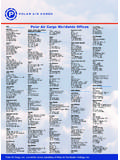Transcription of ELMOD 6: THE DESIGN AND STRUCTURAL …
1 8th international Conference on Concrete Block Paving, November 6-8, 2006 San francisco , California USA ELMOD 6: THE DESIGN AND STRUCTURAL EVALUATION PACKAGE FOR ROAD, AIRPORT AND INDUSTRIAL PAVEMENTS Kars P. Drenth, Manager Consulting Engineering Dynatest UK Ltd 3 Marquis Court, Marquis Drive Moira, Derbyshire DE12 6EJ United Kingdom Tel: +44 1283 554860 Fax: +44 1283 552462 E-mail: SUMMARY ELMOD is an acronym for Evaluation of Layer Moduli and Overlay DESIGN used or the STRUCTURAL assessment of all kind of pavement structures. The latest version 6 of ELMOD is now able to DESIGN pavement structures by specifying the pavement model, the mechanical characteristics for all types of materials and an unlimited number of loading types. Based on the stiffness values of each pavement layer a STRUCTURAL strength can be calculated using mechanistic-empirical principles expressed as a remaining life, needed strengthening or required pavement thickness.
2 The software package is assigning various user controlled transfer functions to each material and is able to apply seasonal adjustments for variations in subgrade modulus due to for instance rainy seasons. The software package therefore may be used for any specific local environmental condition. Within the STRUCTURAL calculation it is possible to select any user-defined combination of DESIGN loads using a vehicle library. Instead of a standard wheel load actual loads can be used in a DESIGN which is in particular useful for pavements loaded by a mix of different vehicle types. For many pavements the lateral distribution of vehicle loads is an important issue. This may be entered based on a normal distribution function. This paper describes the details of the DESIGN of a pavement structure with paver blocks as surfacing layer based on a case study for a container terminal in Ghana.
3 1. INTRODUCTION For the DESIGN of a pavement construction certain criteria have to be established to come to a sound analysis. The characteristics and requirements of heavy-duty industrial pavements do differ substantially compared to highway pavements. Port pavements are subjected to large numbers of relatively high loads at low speed. A DESIGN can be based on semi-empirical methods such as the British Ports Association/Interpave method (BPA, 1996) based on multi-layer elastic modeling principles to produce DESIGN charts using the Lusas finite element package for calibration of the Equivalent Single Wheel Load (ESWL) concept. However such methods are limited in its use, especially in the application of alternative or new materials and different types of transport equipment.
4 Special care has to be taken with the fact 7218th international Conference on Concrete Block Paving, November 6-8, 2006 San francisco , California USA that, especially with respect to cement bound pavement layers and concrete, a relative few repetitions of heavy loads can be very damaging. The ESWL concept can be misleading under these conditions due to the very steep fatigue relationships of cement bound materials in which a small increase of load can result in a dramatic reduction in life time of a pavement structure (CROW, 2002). ELMOD 6 software package has been used to undertake a DESIGN review of the paver blocks surfaced pavement structures of the new extension of the Tema Port Stacking and Marshalling Area B in Ghana. The new DESIGN module of this software package can be readily used for heavy duty industrial pavements such as container terminals.
5 It can handle the variety of mobile equipment used in container facilities with wheel loads that can be of the order comparable to very large aircraft. One of the features of the software is that it takes rational account of vehicle wander. This is the statistical variation of the paths taken by successive vehicles. Increased wander reduces pavement damage and could lead to significant savings. In the mechanistic-empirical approach all layers are represented by their mechanical characteristics avoiding the use of material conversion factors. In many cases concrete paver blocks are used as surfacing material mainly due to their superior characteristics to withstand static loads. Container terminals show a wide variety of heavy dynamic and static loads which makes paver blocks the most versatile product to be used under all these different loading conditions.
6 It is however not only the resistance to static loads that makes this material so useful as surfacing under a wide variation of loading conditions, but also the ease it can be maintained by just replacing damage blocks. There is a tendency to improve on its STRUCTURAL capacity by moving from rectangular to shaped blocks to achieve more interlock, often referred to as progressive stiffening, between the blocks. The heavier the loading the more its functionality does shift towards a material protecting the surface of the main STRUCTURAL layers from being damaged. Creating more interlock between the paver blocks could in that case by counter productive and possibly the mean reason for an increase in paver breakage of especially shaped blocks. 2. DESIGN INPUTS General In the multi-layer elastic model the pavement structure is regarded as linear elastic, in which the materials are characterised by Young s Modulus of Elasticity (E) and Poisson s Ratio ( ).
7 The materials are assumed to be homogeneous and isotropic, and the layers have horizontally infinite dimensions. Similar to the finite element technique, the results of the output depend on the correctness of the input. The primary criteria for the analytical STRUCTURAL DESIGN are considered to be: The horizontal tensile strain at the bottom of a bituminous surfacing or flexural stress in case of a rigid surfacing. There are no criteria for concrete block surfacing in combination with a bound base. The horizontal tensile strain or flexural stress at the bottom of a (cement) bound base or sub-base layer. The vertical compressive stress on top of (cement) bound base or sub-base layers (CROW, 2002). The vertical compressive strain at the top of unbound base and sub-base layers. The vertical compressive strain at the top of the subgrade. Based on these criteria any new material can be included in a DESIGN as long as the material parameters are known.
8 7228th international Conference on Concrete Block Paving, November 6-8, 2006 San francisco , California USA In principle any combination of pavement material is possible, although due to the heavy nature of the loading of port pavements mostly a combination is chosen incorporating some kind of a bound base and/or sub-base layer. For cement bound layers (including concrete) the failure mode is fatigue, typically computed into tensile strains at the bottom of the relevant layers. The strains are converted into damage using a performance model and the Damage Factor for the ith loading is defined as the number of repetitions (ni) divided by the allowable repetitions (Ni). According to MINER s rule the STRUCTURAL pavement life is consumed when the Cumulative Damage Factor (CDF) is equal to 1.
9 The CDF is given by summing the damage factors over all the loading or loading groups in the traffic spectrum: CDF = ni/Ni. The (BPA, 1996) is using the method of expressing the load spectrum in a number of standard or critical loads. As long as this standard or critical load does not differ much from the maximum allowable load the error in STRUCTURAL pavement life is negligible. However care has to be taken with the fact that, especially with respect to bound pavement layers and concrete, a relative few repetitions of heavy loads can be very damaging for a pavement. For this reason the ELMOD software has a more preferable functionality, in which it takes full account of a complete loading spectrum including vehicle wander. Type of LoadingFor the handling of containers the following pieces of equipment have been specified: Reach Stacker (RS) In-terminal Trailer (ITT) Rubber Tired Gantry Crane (RTG).
10 Typical specifications for this container handling equipment are: Reach Stacker: loaded front axle : 1220 kN loaded rear axle : 128 kN tire pressure : 1000 kPa In-terminal Trailer loaded front axle : 175 kN tire pressure : 800 kPa Rubber Tired Gantry Crane (16 wheel): maximum loaded wheel load : 160 kN maximum tire pressure : 1100 kPa.









